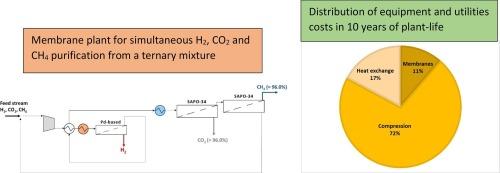CO2 capture combined with H2 and CH4 purification via a membrane plant: Process design, energy integration and economic analysis
IF 10.9
1区 工程技术
Q1 ENERGY & FUELS
引用次数: 0
Abstract
CO2 capture paired with H2 and CH4 recovery from a ternary mixture is studied in this work, with the prospect of finding new solutions able to limit the greenhouse gas emissions, meanwhile proposing a theoretical evaluation of the economic benefits and drawbacks of a membrane gas separation process adoptable for the aforementioned purpose. A simulated plant consisting of three membrane units (i.e., one Pd-based followed by two SAPO-34) allows obtaining pure streams of H2 (about 99.999 %), CH4 and CO2 (about 96 %) with recovery values higher than 90 %. This solution is found to be versatile, since all the components show high purity and recovery at different feed composition.
The preliminary economic analysis, performed to evaluate whether the process can be profitable, is carried out varying the feed flow rate (from 10 to 100 kmol/h), feed material price and labour cost. The biggest plant fed with 100 kmol/h is the most profitable, showing an economic potential more than ten times greater compared to that fed with 10 kmol/h. Compression provides a significant cost (about 72 % of total equipment and utility costs), followed by heat exchange (about 17 %), whereas membranes represent only 11 % of the expenses. Considering the total costs of the simulated plant, raw material has a very high impact, whereas membrane cost can be neglected. The present investigation also reveals that this solution is convenient in a wide range of feed material price and labour cost. For a fixed feed gas price of 0.10 $/Nm3, a net profit of about 940·103 $/y can be achieved, whereas net present value after 10 years approaches 3900·103 $.

膜装置CO2捕集与H2和CH4净化相结合:工艺设计、能源整合和经济分析
本文研究了二氧化碳捕获与三元混合物中H2和CH4的回收,以期找到能够限制温室气体排放的新解决方案,同时对用于上述目的的膜气体分离工艺的经济效益和缺点进行了理论评估。由三个膜单元组成的模拟装置(即一个基于pd的膜单元和两个SAPO-34膜单元)可以获得纯H2(约99.999%)、CH4和CO2(约96%)流,回收率高于90%。该方案是通用的,因为所有的成分显示出高纯度和回收率在不同的饲料组成。为了评估该工艺是否有利可图,进行了初步的经济分析,改变了进料流量(从10到100 kmol/h)、进料价格和人工成本。以100 kmol/h饲喂的最大的植物是最有利可图的,其经济潜力比以10 kmol/h饲喂的植物大十倍以上。压缩成本很高(约占总设备和公用事业成本的72%),其次是热交换成本(约占17%),而膜成本仅占11%。考虑到模拟装置的总成本,原材料的影响非常大,而膜成本可以忽略不计。目前的调查还表明,该解决方案在很大范围内的饲料价格和人工成本方便。固定原料气价格为0.10美元/立方,可实现净利润约为940·103美元/年,而10年后的净现值接近3900·103美元。
本文章由计算机程序翻译,如有差异,请以英文原文为准。
求助全文
约1分钟内获得全文
求助全文
来源期刊

Energy Conversion and Management
工程技术-力学
CiteScore
19.00
自引率
11.50%
发文量
1304
审稿时长
17 days
期刊介绍:
The journal Energy Conversion and Management provides a forum for publishing original contributions and comprehensive technical review articles of interdisciplinary and original research on all important energy topics.
The topics considered include energy generation, utilization, conversion, storage, transmission, conservation, management and sustainability. These topics typically involve various types of energy such as mechanical, thermal, nuclear, chemical, electromagnetic, magnetic and electric. These energy types cover all known energy resources, including renewable resources (e.g., solar, bio, hydro, wind, geothermal and ocean energy), fossil fuels and nuclear resources.
 求助内容:
求助内容: 应助结果提醒方式:
应助结果提醒方式:


